|
Bananaquit Coereba flaveola Reinita,
|
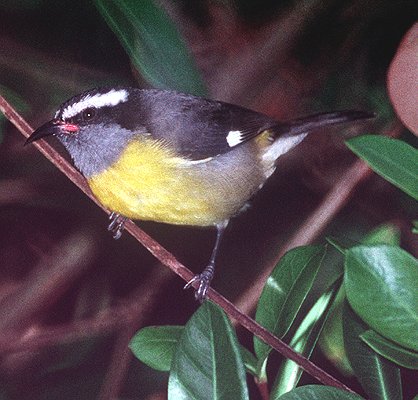 |
|
Photo: M. Oberle
|
|
Bananaquit Coereba flaveola Reinita,
|
 |
|
Photo: M. Oberle
|
|
IDENTIFICATION: The only Puerto Rican land bird with a short, strongly curved bill, the Bananaquit is black above, with a dark gray throat, and a bright yellow belly. It has a white eye stripe and wing patch. A yellow rump patch is striking in flight. Length: 10-12 cm.; weight: 9-10 g. VOICE: The variable song has been described as an accelerating, insect-like trill: "zee-e-e-e swees se tee." It sings throughout the day, but much more frequently at dawn and dusk. It also makes a wide range of drawn out, buzzy and squeaky notes. Audio 8 (M. Oberle). HABITAT: The Bananaquit occurs wherever there are trees, bushes or flowers, from ground level to the top of the forest canopy. HABITS: The Bananaquit is bold, acrobatic, and noisy. It is in constant motion, flitting its wings as it feeds at all elevations in the forest on flower nectar, fruits, insects (small caterpillars, wasps, beetles, lantern flies, and moths) and spiders. It can be attracted to gardens and patios by sugar water feeders, or may just invite itself to the family sugar bowl. It sometimes "robs" nectar by piercing the base of a flower. In forested areas, the Bananaquit often joins tanagers and migrant warblers in mixed-species foraging flocks. The human observer can attract it by making squeaking or "pishing" noises. The male defends a feeding territory, but usually tolerates females and juveniles in the territory. Both sexes build the nest, which is a unique ball of grasses, moss, fine sticks, and other vegetation---and non-vegetative matter---with an entrance hole underneath or on the side, containing 2-3 brown-spotted eggs. May nest several times in one year. The Bananaquit often builds separate nests as safe, night-time roosts, and takes nest material from an old nest to build a new one a short distance away. These roost nests may provide extra insulation to conserve energy at night during cold snaps in the mountains. As in many bird species, the Bananaquit can lower its body temperature 3-5 degrees C. during extremely cold weather. STATUS AND CONSERVATION: The most abundant bird in Puerto Rico. In some forest areas, 2/3 of all birds are Bananaquits. Population density of this species has been estimated at up to 10 birds per hectare in some locations. Bananaquit populations may drop dramatically during periods of drought or after hurricanes, when nectar and fruit are scarce. Genetic studies have shown a low genetic diversity in Puerto Rico, suggesting that the Bananaquit may have passed through "genetic bottlenecks" in the past when the population was decimated by such natural disasters. Bananaquits were absent from Mona Island until a recent human-assisted introduction. RANGE: Occurs throughout the Caribbean islands, except Cuba, where a related endemic species occurs. It also occurs on the mainland from Mexico, south to Peru, Paraguay, northeastern Argentina, and southern Brazil. TAXONOMY: PASSERIFORMES; COEREBIDAE. Bananaquits have such geographic variation in plumage, vocalizations, and genetics from island to island, that some taxonomists have split different island forms into multiple species in the past. For example, one proposed split is to divide the species into the Bahama Bananaquit (Coereba bahamensis) of the Bahamas and Turks Islands, and the Common Bananaquit (Coereba flaveola) in the rest of its range. The Puerto Rican subspecies (Coereba flaveola portoricensis) has a gray throat, whereas the Bahama race (Coereba flaveola bahamensis) has a white throat. |
|
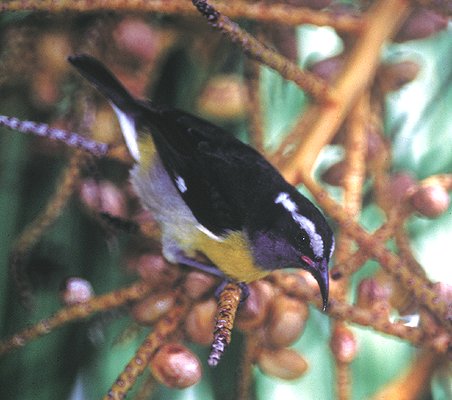 |
|
|
Photo: M. Oberle
|
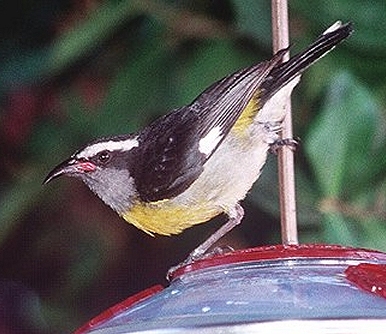 |
|
|
Photo: M. Oberle
|
 |
|
Photo: R. Rodríguez Mojica
|
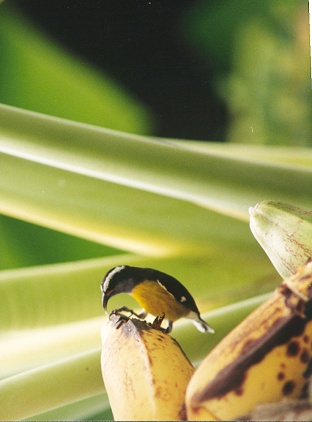 |
|
Photo: M. Colón-Morales
|
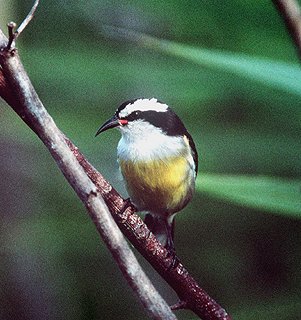 |
|
|
Bahamas race (Coereba flaveola bahamensis)
-
Photo: B. Hallett |
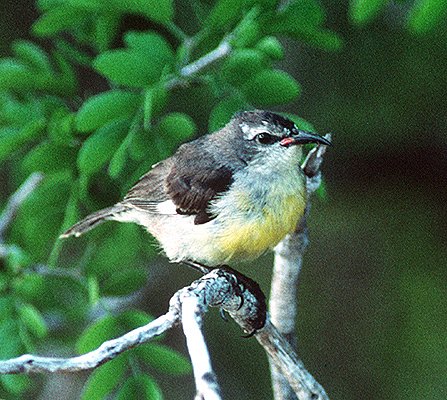 |
|
|
Bahamas race (Coereba flaveola bahamensis)
-
Photo: B. Hallett |
 |
|
|
St. Lucia race (Coereba flaveola martinicana)
-
Photo: G .Beaton |
 |
|
|
St. Lucia race (Coereba flaveola martinicana)
-
Photo: G .Beaton |
|
References Biaggi, V., Jr. 1955. The Puerto Rican Honeycreeper (Reinita) Coereba flaveola portoricensis (Bryant). Spec. Publ. Univ. Puerto Rico Agric.Exp. Sta. 61 pp. Cruz, A. 1980. Avian feeding assemblages in Puerto Rico. Carib. J. Sci. 15:21-27. Cruz, A. 1987. Avian community organization in a mahogany plantation on a Neotropical island. Carib. J. Sci. 23:286-296. Gochfeld, M. 1980. Microgeographic variation in plumage morph frequencies of the Bananaquit (Aves: Parulidae) on St. Vincent, West Indies. Carib. J. Sci. 16:5-8. Hernández, B. 2000. Relación entre la densidad de nidos y la intensidad de depredación de huevos en los nidos cerrados de la Reinita Común. El Bien-te-veo 3(4):2. Klicka, J., K.P. Johnson, and S.M. Lanyon. 2000. Nine-primaried oscine relationships. Auk 117(2):321-336. Lovette, I. J. and E. Bermingham. 2001. Mitochondrial perspective on the phylogenetic relationships of Parula wood-warblers. Auk 118(1):211-215. Merola-Zwartjes, M. 1998. Metabolic rate, temperature regulation, and the energetic implications of roost nest in the Bananaquit (Coereba flaveola ) Auk 115(3):780-786. Recher, H.F. and J. T. Recher. 1966. A contribution to the knowledge of the avifauna of the Sierra de Luquillo, Puerto Rico. Carib. J. Sci. 6:151-161. Pérez-Rivera, R. A. and E. N. Dechoudens. 1996. Use of bird nests by Eleutherodactylus frogs in the Carite forest, Puerto Rico. Carib. J. Sci. 32:201-205. Pérez-Rivera, R. A., and M. A. Laboy-Rivera. 1996. Aspectos de la conducta de un individuo de Alsophis portoricensis y pichones y adultos de Reinita Coereba flaveola durante un episodio de depredación. Carib. J. Sci. 32(4):432-433. Raffaele, H.A. 1989. A guide to the birds of Puerto Rico and the Virgin Islands. Princeton. Raffaele, H.A. 1989. Una guía a las aves de Puerto Rico y las Islas Vírgenes. Publishing Resources, Inc., Santurce, PR. Raffaele, H.A., J.W. Wiley, O.H. Garrido, A.R. Keith, and J.I. Raffaele. 1998. Guide to the birds of the West Indies. Princeton. Ramos, N. I., O. J. Vázquez, and J. M. Wunderle, Jr. 1993. Bananaquit vocal behavior in a high density population. El Pitirre 6(1):10. Rickelfs, R.E. and E. Bermingham. 1997. Molecular phylogenetics and conservation of Caribbean birds. El Pitirre 10(3):85-92. Seutin, G., N. Klein, R.E. Ricklefs, and E. Bermingham. 1994. Historical biogeography of the Bananaquit (Coereba flaveola) in the Caribbean Region: a mitochondrial DNA assessment. Evolution 48:1040-1061. Terborgh, J. and J. Faaborg. 1973. Turnover and ecological release in the avifauna of Mona Island, Puerto Rico. Auk 90:759-779. Wunderle, J.M., A. Díaz, L. Velasquez, and R. Scharrón. 1987. Forest openings and the distribution of understory birds in a Puerto Rican rainforest. Wilson Bull. 99:22-37. Wunderle, J.M., R.A. Cortes, and W. Carromero. 1992. Song characteristics and variation in a population of Bananaquits in Puerto Rico. Condor 94(3):680-691. Next related species in taxonomic order Previous related species in taxonomic order |
|